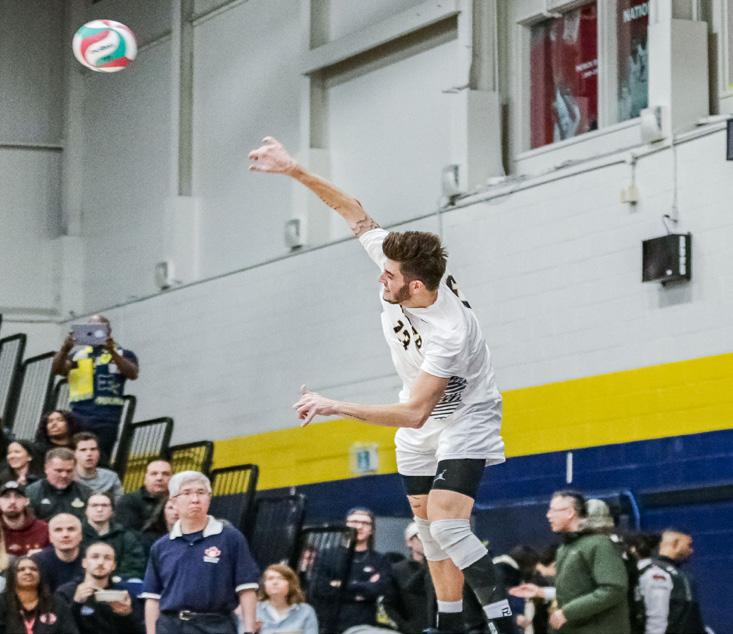






Toronto Police announced Monday that its enhanced presence on the Toronto Transit Commission (TTC) has come to an end.
Police teamed up with the TTC earlier this year in response to the surge of violent attacks that were taking place within TTC spaces.
An additional 80 officers were deployed to patrol TTC buses, subways, streetcars and platforms on Jan. 26 and lasted throughout the month of February.
Chief of Police Myron Demkiw said the intentions behind the additional police presence was to create a safer space for TTC riders and the city at large.
“These deployments will focus on reducing victimization, preventing crimes of opportunity and enhancing public safety,” Demkiw said.
Now that the additional safety services have ended, TPS plans to resume its regular police patrolling, and support the TTC with further security measures when needed.
TTC rider, Mohamed Sikkandar, said the extra police presence during his daily commute provided a secure, more protected experience.
“I felt more protected and safer…I’ve never felt that way before,” he said. “They would sit right beside us, talk to us, tell us that they’re here for us.”
Sikkandar said that he noticed the additional police presence mostly in the evenings between the hours of 6:00 p.m. to 10:00 p.m.
He said that besides being welcoming to the riders, the police assisted vulnerable populations in situations of crisis.
Sikkandar also said that in situations like these, it wasn’t solely him that appreciated the extra police presence, but also his fellow riders.
“People feel much safer when you see a police officer around than if there’s no one else when there’s a problem or an issue,” he said. “They were friendly and ready to help.”
Police said that throughout the enhanced safety program, officers provided more than 220 referrals to those in need of social assistance supports such as food, shelter, and mental health services.
The statement said more than 314 arrests had been made by officers during this time, including an incident involving an arrest and seizure of a firearm at Pioneer Village subway station.
City Manager Paul Johnson told the Toronto 2023 budget meeting on Feb. 15 that the monthly cost of the police initiative was $1.7 million, all of that overtime.
TTC CEO Rick Leary said he was grateful for the swift action police had taken when taking on this project earlier this year, and that the presence of officers is pin-
nacle to TTC safety.
“This partnership is essential to addressing the complex safety and security challenges the TTC has been facing recently,” Leary said. However, not all riders feel as if the TPS are supporting both riders and the city at large.
A TTC rider, who didn’t disclose his identity not to risk his personal safety, said the one-month pilot project with the transit system and police was nothing but a distraction to the bigger picture at hand.

“It was a grab for taxpayer money,” he said. “How did they expect to solve all the TTC’s problems in a one-month pilot project?”
Humber Et Cetera is the Humber College journalism program laboratory newspaper. It is created journalism students in the Advanced Diploma and Post Graduate Certificate programs. Et Cetera serves to inform the Humber community and give its readers well rounded coverage on the things that matter to them.
EDITOR-IN-CHIEF
Scott McLaughlin
NEWS
Eric Sadhu
INTERNATIONAL
Antonio Pelaez Barcelo
POLITICS
Philip Lau
CULTURE
Rheegan Goodale
Maria Kestane
SPORTS
Tessa Bennett
Krystal Yeung
OP-ED
Maegan Lee
ART DIRECTOR
Andrea Pozo
ONLINE/PHOTO
Sajel Mistry
NEWSLETTER EDITOR
Shraddha Bhojane
Heta Khakhar
James Westman
FACULTY ADVISER
Rob Lamberti
TECHNICAL ADVISER
Marlee Greig
FRONT PAGE PHOTO
Scott McLaughlin
The rider said the city should do better to help vulnerable people get warm shelter and housing facilities rather than fund police-based surveillance programs.
“Of course homeless people are going to seek shelter on transit, hell I would too if I were them,” he said.
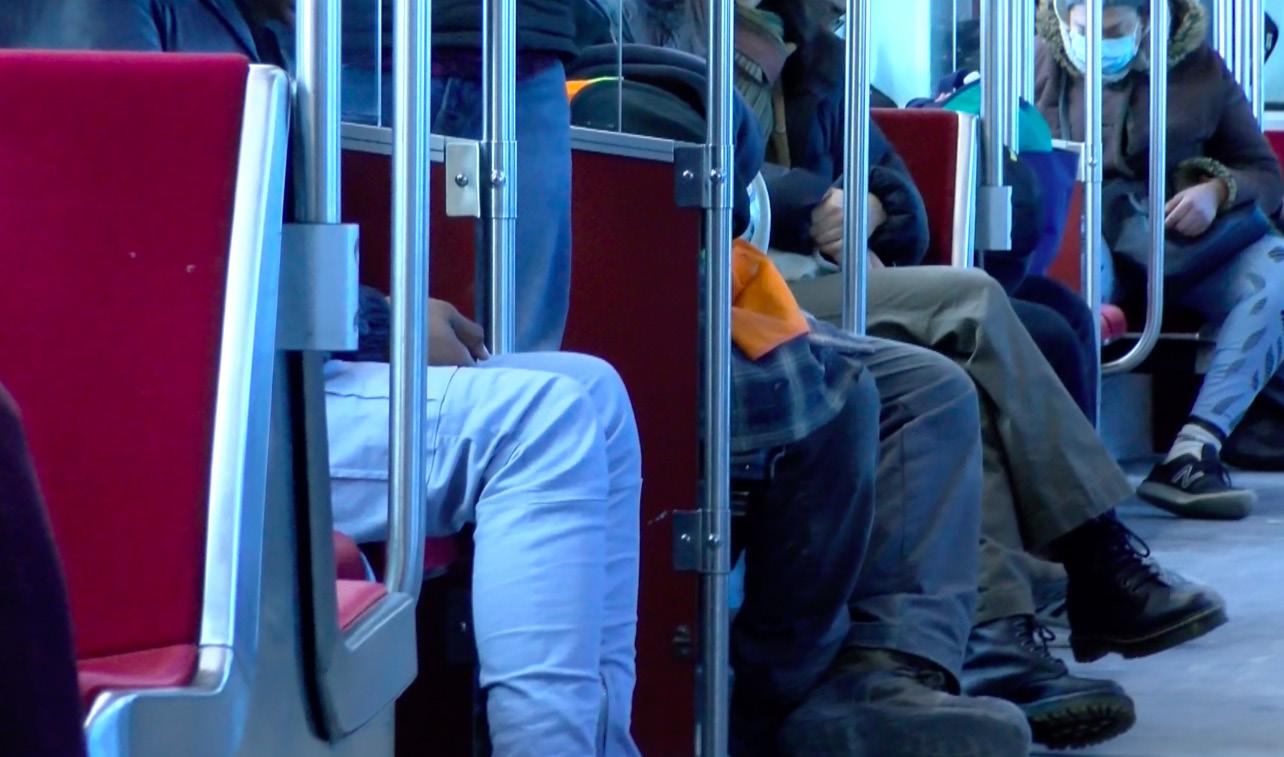
“It was a waste of our time,” he said. “It was a waste of our time and money.”
Following the end of the additional patrolling, TTC has rolled out an SMS reporting program where riders can text 647-4961940 to report immediate matters concerning safety and security.
BACK PAGE PHOTO
Diego Guillen
@HUMBERONLINE
ETC.HUMBER@ GMAIL.COM
HUMBERNEWS.CA
©2023 All rights reserved
Humber Et Cetera is a publication of the Faculty of Media and Creative Arts at Humber Institute of Technology & Advanced Learning 205 Humber College Blvd., Etobicoke, ON, M9W 5L7
The Firgrove-Grassways community is gentrifying after the Toronto Community Housing Corporation (TCHC) relocated more than 241 residents.
TCHC deemed the Firgrove-Grassways buildings unsafe for residents in 2016 and forced them to relocate.
The development of new higher priced units is being built on the site of the homes that were demolished by the Toronto Housing Corporation. They are home that are out of reach for the former residents of the area.
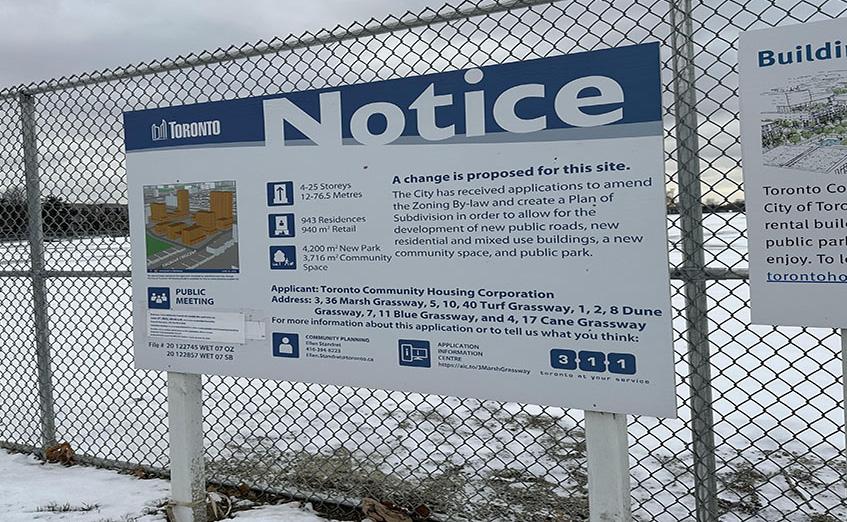
Serena Nolan, a 29-year-old mother who lives in the Firgrove Crescent area, says she is paying too much for a house that isn’t big enough for her needs.
“I thought moving here would be a great idea for my family, but the price is ridiculously high for a small space,” Nolan said.
“My kitchen and living room is one room combined. Me and my husband are always bumping into each other and there’s barely any place to put my kid’s toys,” she said.
The condos at 45 Firgrove Crescent were built shortly after the demolition at Firgrove Grassways.
As part of TCHC’s revitalization plan, all 236 demolished units will
be replaced with rent-geared-toincome units along with the refurbishment of 152 onsite units.
There are up to 600 planned affordable housing units — both rental and ownership — as part of the TCHC project and the construction process is expected to be completed by 2023.
Nolan’s husband Dellon, 30, says he had to pick up extra shifts at work since moving to the Jane and Finch area.
“I work at UPS and had to pick up some night shifts at work. There was no other option between paying rent and trying to afford things for my family,” Dellon said.
The poverty rate in the Jane and Finch area has risen by 3.8 per cent and is expected to rise even higher with the completion of the TCHC project.
“The prices are way too high. The government is more focused on profiting off of us instead of lending a helping hand,” Dellon said.
Other members of the Jane and Finch community expressed concerns about their living conditions.
Rodney Osei, a 19-year-old in the community, said he saw the chaos from relocating residents in 2016.
“I used to live over at 3 Marsh Grassway before my parents relocated us to 50 Firgrove Crescent two years later. It was a hard tran-
sition for my parents,” Osei said.
“They struggled much more to keep us close to Jane and Finch. We used to call this area home, but after seeing how hard my parents have it, it just feels different,” he said.
Gentrification mainly affects minority groups as nearly 20 per cent of families from low-income neighbourhoods suffer from high rent prices.
“The people who live in the
neighbourhood suffer while the government spends money on other s**t,” Nolan said.
The neighbourhood’s cost of living and property values are expected to increase in conjunction with the development of the Finch LRT, according to a MetroLinx study. The study showed that generally, North American residential values along transit lines, called transit influenced appreciation, rose between eight and 10 per cent.
The construction for the Finch LRT began in 2019. There will approximately be 11 kilometres of light rail transit along Finch Avenue from the planned Finch West subway station at Keele Street to Humber College.
“Neglect like this is bad for people. Everything is escalating and living like this is not possible. Before the pressure and costs kill us, something has to change,” Dellon said.
Humber College and the University of Guelph-Humber has a student government following last week’s voting that attracted more students that in the recent past.
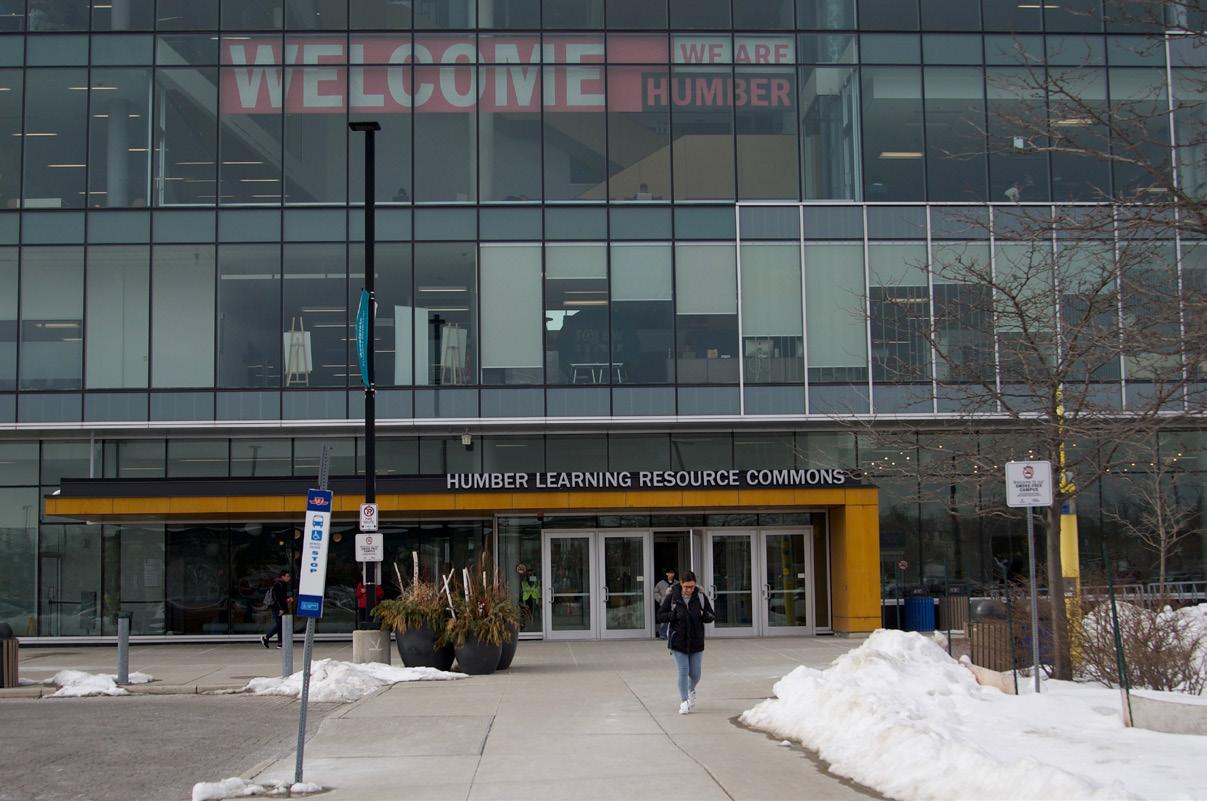
The results for for 2023-2024 are in and one-third of the students cast their votes.
IGNITE, the student union at Humber College and the University of Guelph-Humber, represents about 30,000 students and is handles more than $13 million worth of student fees.
This year 23.6 per cent of eligible voters — compared to about nine per cent last year — picked thye IGNITE board of directors.
Shanell Roy, who won with 43 per cent votes at Humber North, said this year the voter turnout was more because it is a post-pandemic year.
“We are coming from the era of the pandemic,” she said. “A lot of students are still shy, some of them are still in their shells”.
Roy said she didn’t expect her to
win because she didn’t get many attendees at the Women’s Day event last week.
“I literally had a breakdown on campus because this is me trying to help them to build their professional portfolio,” Roy said.
She said her biggest fear is not being able to help the students.
“This fear will be stemming from students not having the courage to visit the IGNITE website,” Roy
said.
The elections were held last week with a total of 14 candidates competing for the positions on the board of directors. The nine elected student representatives will serve Humber College North and Lakeshore campuses and University of Guelph-Humber students.
Angad Handa, who won with 14 per cent of votes at Humber
North, said student advocacy will be his top priority as a member of IGNITE.
“There are some issues and concerns like on-campus jobs, the parking lot issues, and many other issues that need to get a limelight”, he said.
Handa said he has always been active in leadership roles as he was the captain of the cricket team back home in India.
He said as a leader he is someone who likes to work in a team.
“I would like to work with everyone and get their suggestions, their ideas and put work to it,” Handa said.
Navjot Singh, who won with 21 per cent of votes at Lakeshore, said his police foundations program inspired him to run for this election.
“My program teaches me all about leadership and this election was an opportunity for me to get experience in leadership and serve the students,” he said.
Jenny Trang, who received 25 per cent votes at Guelph-Humber, said her top priority for the upcoming
year is to be as transparent as possible with the students.
“I think it’s extremely important for the students to know what is going on with their student union and what decisions are being made for them,” she said.
Trang said she is grateful after winning as everyone has put in a lot of hard work during the campaigns.
“After two weeks of campaigning, I understand how much hard work every single candidate put into this election,” Trang said.
Roy said she is looking forward to working for student advocacy in the future.
“There’s so much more work to be done. And the good work must go on,” she said.
The North representatives on the Board of Governors are: Chair Jessica Urzua Cordon-Carrera Valle, Marisa Ulloa-Cornejo and Aksnoor Singh Kamboj. The Lakeshore directors are Neha Singh and Parul Yadav. GuelphHumber directors are Fiona Mahadeo, Brittany Bartolome and Lauren Abela.
Ontario’s six-year health care spending plan is expected to fall short of what’s needed to meet the demands of the system.
According to a review by the Financial Accountability Office of Ontario (FAO), the province will require $93.8 billion to address shortages in the health sector. But the money being invested is $21.3 billion below the expected funding requirements.
NDP health critic France Gélinas said there shouldn’t be a deficit because the province has the money to spend.
“This is a big amount of money, but it’s small compared to the amount of money that the government is stashing away,” she said. “Every amount that is not spent on health care means that people wait longer in our emergency rooms to get the care they need. It means that people wait longer to get the surgeries they need.”
The provincial government has proposed adding money to
existing health sector programs and expansion commitments to address surgical backlogs, staffing shortages, and hospital capacities. However, the review highlighted that the demand is expected to grow every year and will create a bigger offset if the proper investments are not made.
To meet the forecasted cost, the FAO recommended that the province either take money from contingency funds or make changes to its proposed plan.
In response to the solutions given by the review, Gélinas highlighted last week’s FAO third quarter report which listed more than $605 million of unspent funds from the federal government to be used towards COVID-19 response programs.
The unspent funds could be used to reduce the deficit, but the government has not yet confirmed where that money will be spent, the FAO said in its report.
“The federal government gave it to [the province] for healthcare, and yet they did not spend it on healthcare. It’s shameful when
you have so many people right now who feel that the healthcare system is not meeting their needs,” Gélinas said.
However, Gélinas said solutions begin with improving the treatment of Ontario’s healthcare workers.
“The last three years, working through the pandemic, was tough, really difficult,” she said. “Many of them got sick but needed to go to work anyway. They were mandated to work overtime.
“Respect the people that are there, pay them a fair wage, bring back the people that were so discouraged and felt so disrespected that they left the system,” Gélinas said.
Raisa Deber, a professor at the University of Toronto’s Institute of Health Policy, said the province should not focus on providing “an exact number.” Instead, they need to evaluate the needs in Ontario and be aware of what could be needed in the future to avoid repeating mistakes of the past.
“One of the things that are catching up with Ontario now and a number of the other prov-
inces is that they really cut back on how many hospital beds they had because they didn’t want to have excess capacity,” she said. “When the pandemic hit, they suddenly found that they didn’t have the resources they needed.”
Health Minister Sylvia Jones did not respond to an email request for comment.
Chief Medical Officer of Health
Dr. Kieran Moore echoed Deber’s concerns in his annual report. He highlighted the need for “preparedness” at a level that will have Ontarians ready for the “next pandemic.”
To meet this goal, the report prioritized a need for further investments in the public health sectors. Moore said he doesn’t want to see a cutback of funds in health care.

“As we have seen in the past, public health resources are often scaled back after health emergencies as governments move to address other priorities,” he said in the report. “We need to invest in public health up-front and consistently. This investment will be cost-saving and provide many
long-term social and economic benefits.”
The FAO review has outlined that the gap for what’s needed to fund health care through 2028 could be higher than what’s forecasted if the wage-suppressing legislation, Bill 124, remains struck down. Premier Doug Ford’s government is appealing the Superior Court of Ontario’s decision made to strike down the bill, which limits wage increases of provincial workers to one per cent.
Gélinas criticized Ford for appealing Bill 124 and said the gap between what’s needed and what the “government is willing to spend” will get bigger. She stressed if there is a focus on healthcare workers, some of the shortfalls may decrease.
“Sit down and negotiate with them and give them hope. Give them respect. You will be amazed at what they will do. They are human beings,” she said.
“We have solutions right here in Ontario. It will require a little bit of money, yes, but we have the money,” Gélinas said.
Chloe Brown, who placed third in the 2022 Toronto mayoral election, announced that she will be back on the campaign trail for the upcoming by-election.
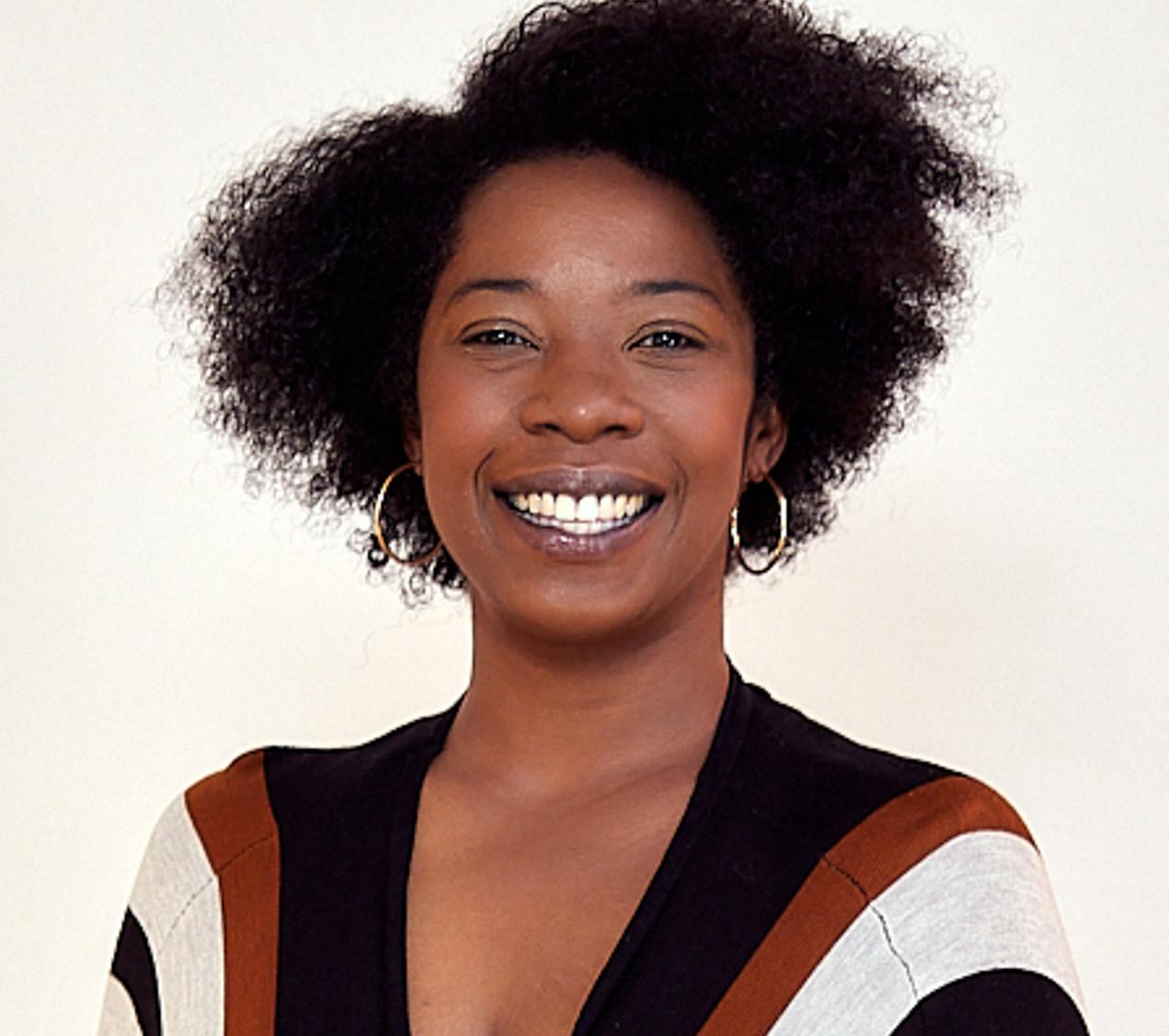
“The first time I was running to be heard, now I’m running to win,” Brown said to Humber News.
Brown received more than 34,000 votes on the Oct. 24 election, trailing behind urbanist Gil Penalosa, and former Toronto mayor John Tory.
Penalosa, who placed second, said in interview with Humber News last month that he also plans on running in the by-election.
The City of Toronto said a by-law requiring a by-election is set to pass at the next city council meeting on March 29, 2023.
Nominations will open on April 3, 2023 and close on May 12, 2023 with the by-election taking place on June 26, 2023. The by-election was called after Tory resigned from the post after admitting to an extramarital affair with a staffer.
Then Deputy Mayor Jennifer McKelvie has taken on the job of interim mayor.
Brown said she plans on run-
ning in the by-election because she has a responsibility to continue the campaign she started last year.
“People put their faith in me to represent them, I can’t pay that back unless I get them what they ask me for,” she said.
Brown said one of her top priorities heading into the by-election is advocating for accessible and affordable housing in the city.
She said the city must first address how the lack of affordable housing impacts people with disabilities, before dealing with the issue of housing affordability.
“There are people experiencing homelessness because there is not enough affordable housing for people with disabilities,” she said.
“If we can start with that issue then building housing for the rest of us shouldn’t be a problem.”
One of the ways Brown suggests the city can help tackle affordable housing is through her proposed digital product called RentSmart.
Brown described RentSmart as a centralized digital system that will give renters equal access to housing listings across the city.
Although the product is yet to be developed, she said the need for affordable housing is an issue that hits close to home.
“I grew up in Rexdale with my siblings and my parents in a two-bedroom apartment, and my parents slept in the living room because they wanted me and my siblings to have a room,” she said.
“I know how important it is for people who may not have grown up with wealth or privilege to have a stabilized independent space.”
Brown’s 2022 campaign advocated for more civic participation and stressed the need for increased opportunity for Toronto residents to be more involved in municipal planning.
Brown continues to highlight this goal heading into this year’s by-election.
“A few months ago I was a nobody, then I finished third,” she said.
“This is how societies are built, when ordinary people do a little something extra when the establishment least expects it,” Brown said.
Brown said Tory’s resignation creates an opportunity for Torontonians to make the changes that elected officials have been unable to do.
“There is a vacuum of power that needs to be filled, and this might be the time for working class people to get on that platform and actually be heard after so long,” she said.
“So, I’m hopeful for us.”
Looking back on her 2022 campaign, Brown said choosing to speak directly to working class people was a true win for her.
“I did not expect my message to resonate with 34,000 people but I’m not surprised that it did,” she said. “I needed to get justice for us, that was the bigger win for me.”
As she prepares for the by-election, Brown said she wants to remind Torontonians that although some have lost faith in the mayor’s seat, the city is still worth fighting for.
“We have to reimagine our role in the fight instead of being like ‘someone else will do it,’” she said. “You are somebody else.”
An online petition requesting McDonald’s Canada to bring food options from the Indian McDonald’s menu has recently gained traction in Brampton.

Anuj Patel, who started the petition wrote “McDonald’s Canada has very limited options for vegetarians as compared to McDonald’s India.”
Patel started this request on Change.org two years ago in order to bring vegetarian alternatives to the popular food chain for Canadians.
The petition has been gaining momentum and is approaching 7,500 supporters, which, according to Change.org is an important milestone for it to get a reaction.
“There are a variety of options that we would love to be introduced in Canadian McDonald’s menu, which would cater to the vast majority of (the) vegetarian population residing in Brampton,” Patel wrote.
According to the StatCan report from 2021, there are approximately 197,000 residents in Brampton who have Indo-Aryan or Dra-
vidian mother tongues.
The petition asks for items like McAloo Tikki burger, McSpicy Paneer burger, McVeggie burger, McSpicy Chicken burger, Piri-Piri fries and Veg Pizza McPuff.
Although McDonald’s Canada hasn’t released an official response to the petition, a spokesperson told Yahoo News Canada it is committed to offering a variety of menu choices.
It said it would continue to listen to their guests to understand their needs, changing trends and evolving tastes.
Eshani Baijal, of Brampton, said religious restrictions do not allow her to eat meat on some days of the week.
This makes it difficult for her to eat out at any fast-food chain due to a lack of vegetarian food options, she said.
“I cannot just always eat fries,” Baijal said. “It would be great if some food choices from the Indian menu are introduced here.”
A petition supporter said on the website that McDonald’s should make vegetarian options available all over Canada, not just in Brampton.
“The flavours will kill it here,”
Vegetarian food items are
the petition supporter said. Another supporter said the petition, if sucessful, will introduce more options for vegetarians in
Brampton.
“As of now, people have nothing to select from the menu, especially in Brampton,” that supporter said
on the website.
Former governor general David Johnston will be the special rapporteur investigating alleged foreign interference in Canadian federal elections, Prime Minister Justin Trudeau announced Wednesday.

“I am confident that he will conduct an impartial review to ensure all necessary steps are being taken to keep our democracy safe and uphold and strengthen confidence in it,” Trudeau said.
Trudeau said his government will comply with Johnston’s recommendations following the investigation, which could include a formal inquiry or other independent review processes.
The move to name a special rapporteur is a response to allegations of Chinese interference in the 2019 and 2021 federal elections, first reported by the Globe and Mail in late February.
The Globe and Mail said China deployed tactics, such as disinformation campaigns and cash donations to candidates viewed
as friendly to China, based on a review of leaked documents prepared by the Canadian Security Intelligence Service (CSIS).
The report also said China wanted a Liberal minority government and the defeat of vocal China critics such as Kenny Chiu, who lost reelection in his British Columbia riding in 2021.
These allegations have stirred up much debate in federal politics.
The Conservatives lined up with the New Democrats at the Standing Committee on Procedure and House Affairs, passing a non-binding motion on March 2 to call for a public inquiry into the matter.
Trudeau has resisted calls to launch a public inquiry directly, saying an independent expert can better reassure Canadians of elec-
tion integrity.
“Because this is not about what one political party says or another,” he said.
Margaret McCuaig-Johnston, a commentator on Canada-China
year, and be led by an independent judge, who will have security clearance and access to sensitive documents
McCuaig-Johnston also said although the leakers can be other senior government officials who also have access to sensitive documents, she felt Canadian authorities have overlooked advice from the intelligence agency for too long.
Cherie Wong, a member of the advocacy group Alliance Canada Hong Kong, expressed concerns on Twitter about the privacy and security of dissidents, who she said have deep knowledge about Chinese interference but are afraid of speaking out.
Her advocacy group published a report in May of 2021 about a suspected Chinese network of interference in Canada.
The report said one tactic used by China was the surveilling of Chinese communities in Canada, but such actions were often framed as civil disputes instead of coordinated attacks on opposing voices.
relations from the University of Ottawa, said the Trudeau government should launch a public inquiry as soon as possible.
“We cannot go into the next election with big questions hanging over Canada about whether certain ridings were won by the wrong [people],” McCuaig-Johnston said.
She also said the inquiry should have a short term of under one
“If CSIS was able to determine that irregularities were happening, the riding president and others should have been aware of that as well and should have prevented it [them] from happening to begin with,” she said.
But some members of Chinese Canadian communities have sounded alarm bells about blanket calls for a public inquiry.
“The lack of awareness and response are major barriers in protecting the Charter-guaranteed rights and freedom of Canadians,” the report said.
Wong tweeted that response to China’s threats should not be performative political moves, but include systemic changes in Canadian institutions and sincere engagement with the dissident communities.
“WE CANNOT GO INTO THE NEXT ELECTION WITH BIG QUESTIONS HANGING OVER CANADA ABOUT WHETHER CERTAIN RIDINGS WERE WON BY THE WRONG [PEOPLE]”
Margaret McCuaig-Johnston Senior Fellow in the Institute for Science, Society and Policy, University of Ottawa
Humber’s First Year Experience (FYE) program hosted the International Women’s Day celebration, an annual event to honour women’s rights and commemorate women’s achievements all around the world.
FYE Senior Peer Mentor and leading organizer of the event, Sama Jesow, said it’s important women and their achievements be celebrated through events like these.
As the seatbelt sign gleams overhead, and takeoff announcements play in-flight, nervous flyers understand there’s nowhere to go, but up.
Flight anxiety is an extremely common phenomenon, experienced by millions in Canada, alone.
Dr. Ian Shulman, a clinical psychologist specializing in flight anxiety, said flights are one of the few situations where people feel no sense of control.
“People have to end up sitting with their own stuff, their own feelings, their own thoughts,” Shulman said. “And that’s really uncomfortable.”
Shulman said people are masterful at avoiding discomfort dayto-day, through the use of cell phones, conversation, or even a change of environment. In an airplane though, he said there’s less opportunity to distract from anxious thoughts.
In an environment where control is non-existent, turbulence is bound to act as a trigger, and contribute to this anxiety.
“We can’t stop it,” Shulman said. “We don’t know how long it’s going to last, and then it could be really awful when it comes.”
Climate change is escalating the problem.
Isabel Smith, a PhD student at the University of Reading, is currently investigating changes
in atmospheric turbulence using high resolution climate models. She said clear-air turbulence is increasing as a result of climate change.
Smith said clear-air turbulence occurs in cloud free environments, and is mainly related to the changes in wind speeds. She said three per cent of the atmosphere has light turbulence occurring within it, and this number is expected to increase.
Luckily, Smith said these percentages decrease with severity. She said the likelihood of encountering severe turbulence is only about a tenth of one per cent.
“Light turbulence is not life threatening,” Smith said. “It just means that it’ll be a much bumpier ride.”
But in recent years, people are quicker to perceive situations as dangerous, or disasterous, even when they pose no practical threat.
Shulman said societally, tolerance for discomfort has gone down since the COVID-19 pandemic.
“COVID and and a lot of things have made people more anxious, more distressed, less resilient, and less tolerant of discomfort,” he said.
Smith said while it is jarring, pilots can navigate their way out of clear-air turbulence quite easily.
“It’s like a pancake, really thin, but really wide,” he said. “They normally go above it so they’re out of it quite quickly, but it’s just that initial shock.”
Shulman said even light turbulence is enough to engage an anxious flyer’s fight-or-flight system. He said turbulence is not something we can anticipate, and its presence alone is enough to induce anxiety during a flight.
He said the human body is built to react to sudden changes in our environment. Shulman said even when any level of turbulence hits, our autopilot system flips off, and our alarm system turns on.
“The pilots all say the same thing, which is that turbulence is not dangerous, especially for airplanes,” he said. “Turbulence is just uncomfortable.”
Shulman said regardless, pilots try to avoid turbulent air in order to keep themselves, and their passengers comfortable.
While it may seem like a foolproof solution, this poses another key issue.
Manoj Joshi, a professor of Climate Dynamics at the University of East Anglia, said with more turbulence in the air, avoiding it comes with consequences. He said changing routes to avoid turbulence results in higher fuel emissions, and more carbon being released into the atmosphere.
“At the minute, flights are a pretty small contributor to global warming, but they are predicted to become a much bigger contributor in future,” he said.
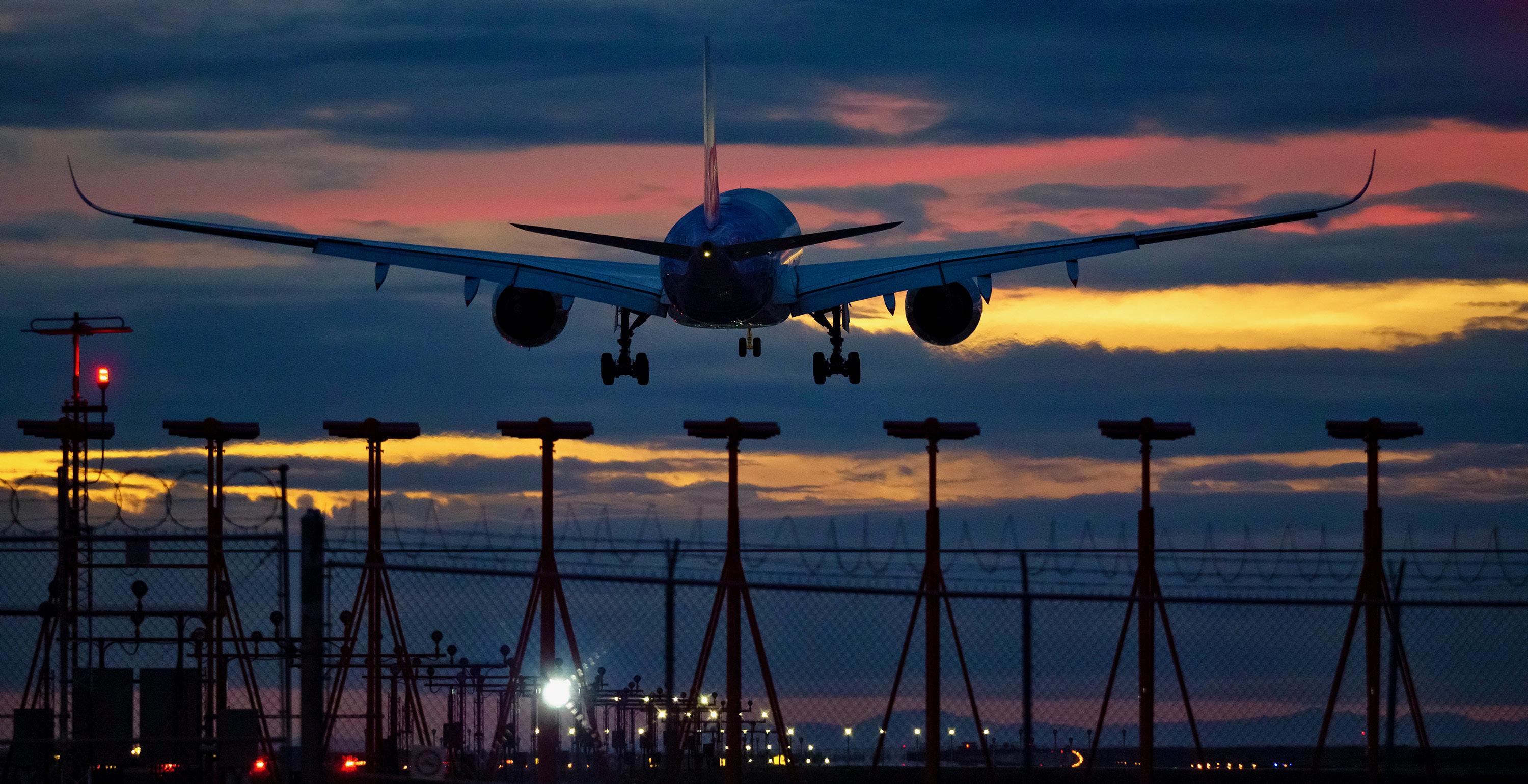
Joshi said one of the major reasons for climate change is the emission of carbon dioxide into
the atmosphere from industrial sources.
Smith agrees. She said the aviation industry has no real way of stopping or reducing their emissions. With that said, these emissions will likely contribute to a further increase in turbulence levels over time.
“The unfortunate thing is [turbulence] is increasing with climate change, which increases the likelihood of encountering it,” she said. “It’s still pretty small, but the number is getting larger.”
This new combination of increased turbulence rates, and a lower tolerance for discomfort makes it much more likely for anxious flyers to be triggered inflight.
Thanks to climate change, this will undoubtedly be the case. But thankfully, there are ways to alleviate flight anxiety.
Shulman said there’s no onesize-fits-all solution to flight anxiety. That said, he works with his clients to develop an operator’s manual for their own bodies, to understand their own patterns and reactions to fear.
He said throughout the entirety of their lives, people are very good at distinguishing real alarms from false alarms. In a time where turbulence is increasing, he said people need to apply those same skills during a flight.
“Don’t avoid,” Shulman said. “Feel your feelings, and let yourself ride through them so that you can get to the other side.”
“There’s so many things that women have contributed to the world, and struggles that women have been through,” she said. “It’s really important to appreciate, not just on International Women’s Day, but everyday.”
The event attracted crowds of students, and FYE provided refreshments, activities and free services for visitors to enjoy.
FYE Senior Peer Mentor Aashish Arora said that for attractions such as the Humber Spa booth, students were required to visit the registration table to pick up tickets to participate.
The other activities were open without registering.
Activities included a button-making station arranged by Humber’s Consent Peer Education Program (CPEP), a table with thank you cards for students to write appreciative messages for women, and a safety informational booth managed by the Department of Public Safety at Humber.
The safety booth provided brochures with information about Humber’s Guardian app and its features that students can utilize.
One of its features is the campus walk, where upon request, staff members can walk students to their classes, in and out of the parking lots, and other areas of the campus.
The Public Safety Department Coordinator David Yen said the department will also be holding violence minimization training on March 23 on the Lakeshore Campus and on April 4 on the North Campus for students and staff.
There are many flaws within the incarceration system in Canada.
In the wake of the COVID-19 pandemic, Canada has seen a shift in priorities and allocation of resources, specifically within the healthcare industry.
While there has been an increase in support for mainstream healthcare operations, such as hospitals and clinics, federal prisons have been left behind, and the government is not doing enough to support and fund this part of society.
Ontario is home to only one prison that doubles as a mental health treatment facility, where it hosts inmates from all of Ontario as well as Yukon.
This is not sufficient for the growing mental health needs of Canada’s incarcerated population.
According to the John Howard Society of Ontario (JHSC), a nonprofit organization dedicated to dealing with incarcerated persons in a humane way, close to half of the people in prison will experience at least one serious mental
health problem while serving time.
The Millhaven and Bath institutions, located in Kingston, Ont., are where all inmates experiencing mental health issues are placed. But the employees of this facility are not just responsible for helping to rehabilitate and treat these people.
Employees of Millhaven, a maximum security institution, are also responsible for assessing newcomers to the location as well as responding to crisis calls, which is no easy feat.
This has left mental health professionals and other correctional officers overworked and without sufficient resources to rehabilitate this population.
Deputy Prime Minister and Minister of Finance, Chrystia Freeland, said in a press release that since the beginning of the pandemic, the federal government has allocated over $60 billion to support health and safety in Canada.
Meanwhile, the total amount of public funding designated to all levels of criminal justice in Canada per year is only about $20 billion, according to the JHSC.
In addition, legislation like the Canada Health Act, which provides publicly funded healthcare for Canadians, excludes people in federal penitentiaries.
According to a mental health professional employed by Millhaven, who was interviewed under the condition that they not be named, the work they do is very challenging and more resources are always needed.
“I would definitely say that staffing is a general issue in corrections, particularly in mental health departments,” the person said. “And it’s really challenging, the work that we do, and the people that we work with at the treatment centre. So, staffing is an issue in terms of turnover and even resource allocation.”
While some attempts to move towards bettering the conditions of prisons in Canada have been made, it is still not enough.
The same source also said
because Millhaven is the only mental health treatment facility in Ontario for prisoners, many inmates are forced to relocate far from their families and support systems.
This shows the need for Ontario to fund a new prison mental health treatment centre.
Additionally, throughout the pandemic, prisons have faced the same issues the public faced: no visitation rights and consistent isolation.
Most people in Ontario had the option of isolating themselves with family or friends, but inmates were confined to their cells, alone, for lengthy periods of time. This put a greater strain on the overall mental well-being of people incarcerated.
“There were lots of periods of isolation over the last two years for the inmates and they were isolated in their cells, and it was horrible for people’s mental health and that just shows you more how important connection is,” the source said.

Several countries take a very different approach to incarceration.
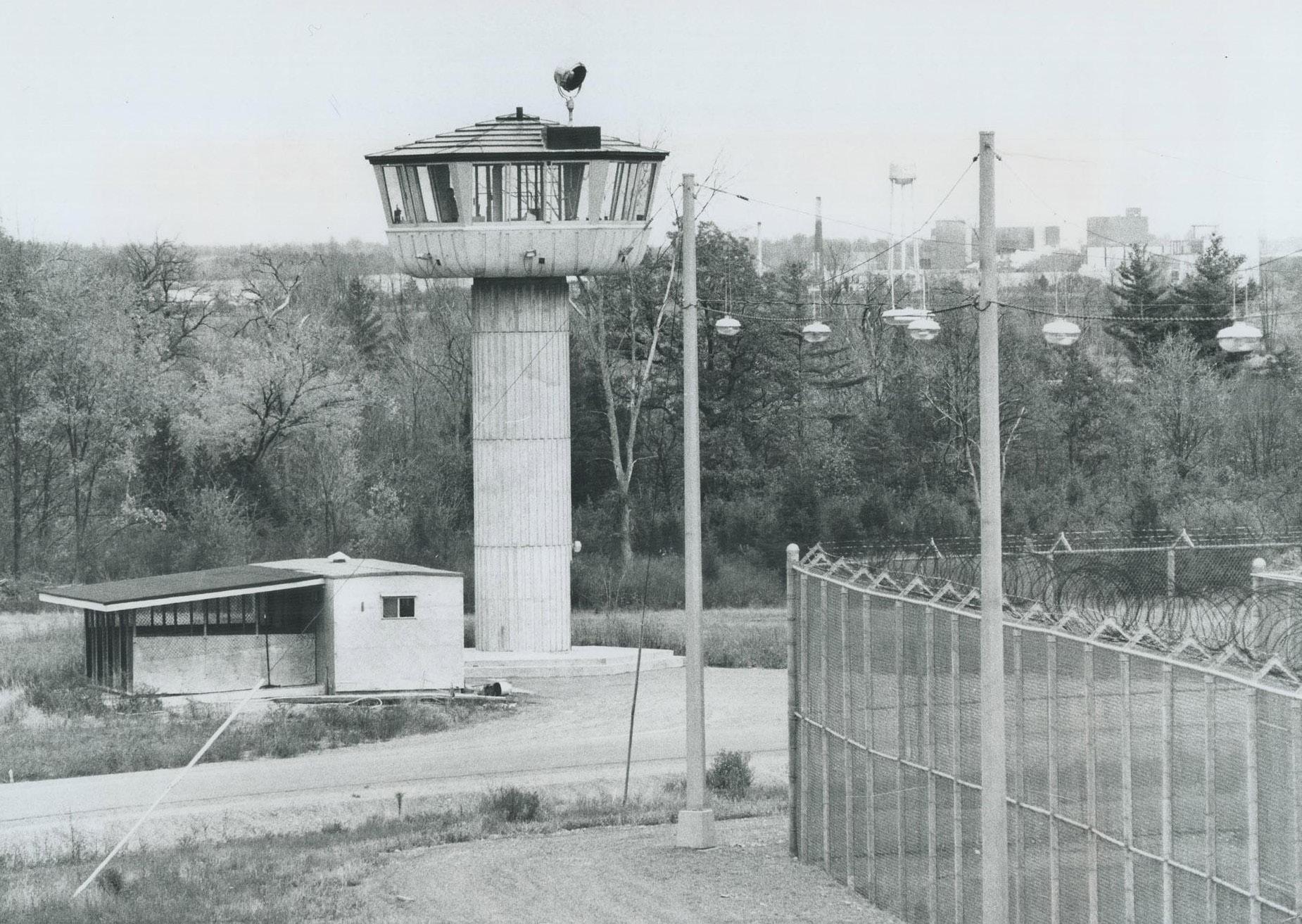
Countries in Scandinavia, for example, allocate more funding to a rehabilitative model of incarceration as opposed to a punishment model used in North America.
This kind of approach has been proven to lower the rates of recidivism, according to Public Safety Canada.
Overall, Canadian institutions are being adversely affected by a lack of funding for health care. The government needs to take mental health support for inmates as seriously as it takes the support for the general population.
dures, which said campus operations will resume normal the day after the closure unless otherwise stated.
Tweets from the college were slightly clearer, which said students should consider campus to be reopened unless a new notice was posted before 6 a.m. the next day. But such tweets did not stop students from asking for updates either.
Philip Lau EditorCommunication is important for students both before and after a school closure. Humber needs to remember this principle and revise its protocols during severe weather.
Humber announced severe weather closures three times this winter. The college notified students and employees of the closure through emails and updates on its social media and websites.
But each time, the college did not make an announcement the following day on whether campus was reopened. It referred students and employees to its severe weather closure procedures in its emails instead.
The current protocol is hidden in section 6.1 of the college’s proce-
Somewhat surprisingly, Humber is not the only post-secondary education institution following this line of thought. The University of Toronto also has a policy that the school automatically reopens the day after a closure.
True Whitmore, a student enrolled in the culinary management diploma program, said it is fair to assume the college is open, but this doesn’t mean students will return to class.
“I feel like a lot of people do miss classes because they just expect for (the college’s) notice,” Whitmore said.
But behind these expectations are legitimate concerns.
According to the National Oceanic and Atmospheric Administration in the United States, most deaths from winter storms result from traffic accidents on icy roads, or even heart attacks when people shovel or plow their ways out.
The immediate aftermath of a
winter storm, therefore, is not a resumption to normal as some people may think.
This is especially true for Humber students. The college does not regularly collect data on where students live, but a survey conducted by Smart Commute Toronto in 2013 showed 30.76 per cent of full-time Humber students lived more than 10 kilometres away from North Campus.
Jasmeen Kaur, another student from Humber’s culinary school, said she sometimes feels unsafe to travel back to campus for morning classes the day after a winter storm, as snow on the roads has been cleared yet.
Some students simply make their own judgements. Julia Giurdanella, who studies kinesiology at Humber, said most of the time she skips her classes if she feels weather conditions have yet to become alright.
Humber allows students to decide on their own. In a campus closure reminder posted last December, the college said students can email their professors about not coming to class if they think roadways near their homes or the college remain unsafe.
The reminder has not been repeated since then. For some students, such a simple reminder after
a winter storm can do the trick.
Yun Nan Soh, a mechanical engineering student at Humber, said it will be better for the college to say campus is reopened in the early morning after a winter storm.


Whitmore said an early update will make her life less stressful, as she needs to get up at 5 a.m. to get on the bus for morning classes.
“I don’t know if it’s gonna happen,” she said.
For the University of Toronto, the school announced on Twitter each morning after a winter storm that campus was reopened and reminded students to plan for extra travel time, although it is not obliged to do so under the current policy.
Humber can learn from the University of Toronto. The college can provide similar updates after a severe weather hazard so students will not be left in the dark.
tently voted against a resolution since 2018 calling on all countries to sign, ratify and comply with the TPNW. As a NATO member, Canada supports the “retention and potential use of nuclear weapons on its behalf.”
James Westman Newsletter Editor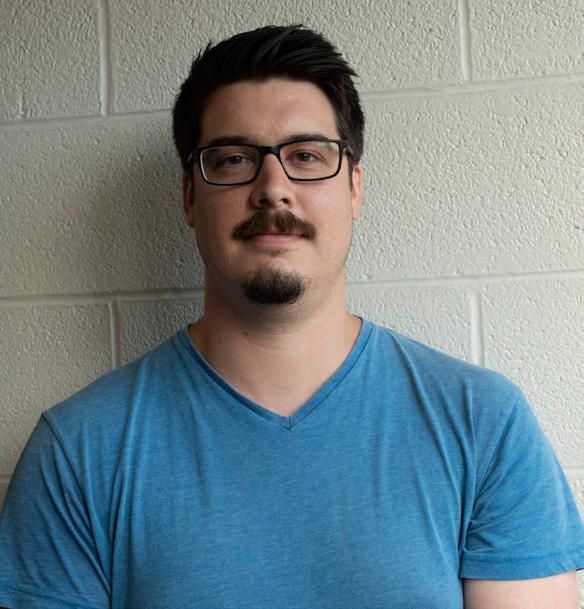
In order to safeguard the security of all Canadians—and human civilization—Canada should sign and ratify the Treaty on the Prohibition of Nuclear Weapons (TPNW).
The treaty, for which the International Campaign to Abolish Nuclear Weapons (ICAN) won the Nobel Peace Prize in 2017, has been signed by 92 countries and entered into force in 2021. ICAN labels Canada a “nuclear weapons endorser”.
At the UN, Canada has consis-
On Jan. 24, the Bulletin of Atomic Scientists moved the Doomsday Clock forward to 90 seconds, citing Russia’s “thinly veiled” threats to use nuclear weapons and the risk of escalation in the Russia—Ukraine war by “accident, intention, or miscalculation.”
This is the closest to midnight— the end of human civilization, if not humanity itself—the clock has ever been.
Only weeks later Russia suspended involvement in New START, the last remaining bilateral nuclear arms control agreement with the United States.
On Tuesday, a U.S. surveillance drone was downed by a Russian fighter jet, raising fears of escalation between the two nuclear superpowers.
Investigative journalist Jeremy Scahill calls the Russia—Ukraine war a proxy war and highlighted
that the U.S. has been providing Ukraine with “actionable intelligence from satellite imagery, from drone imagery” that Ukraine uses to strike Russian targets. “From Russia’s perspective, this is a provocation on the part of the United States,” Scahill said.
This does not alter the fact of Russian aggression both in this instance and in their illegal invasion, but it does show how both nuclear superpowers could misinterpret each other’s intentions in the fog of war.
James Acton, co-director of the nuclear policy program at the Carnegie Endowment for International Peace, estimates there is a 20 per cent chance Putin would use a tactical nuclear weapon if Ukraine attempted to retake Crimea. Canada, as a NATO member, lives under the United States’ nuclear umbrella. Some Canadians may find this reassuring.
David Welch is a university research chair and political science professor at the University of Waterloo and Balsillie School of International Affairs. In an interview with Humber News, he was
emphatic that, despite possessing no nuclear weapons of our own, Russia’s nuclear war plans include “plenty” of nuclear bombs for Canada.
Nuclear bombs dropped on cities from Vancouver to Montreal would only be the beginning. A peer-reviewed article in Nature Food released last year revealed that in the event of full-scale nuclear war between the U.S. and Russia, 360 million people would die directly from the nuclear bombs.
Such a nuclear war would loft black soot from burning cities 10-50 km above the earth’s surface where it would remain for over a decade and cool the earth enough to wipe out agriculture in the northern hemisphere.
By the second year after nuclear war began, over 5.3 billion people could starve to death.
That includes 34 million Canadians (according to 2010 data, when Canada’s population was 34 million).
Canada’s involvement with nuclear weapons is more extensive than many may realize.
The Eldorado mine in Great Bear Lake provided uranium for the Manhattan Project (which created the atomic bomb) and caused cancer in the Dene peoples who carried it without being informed of the danger.
Setsuko Thurlow is a Hiroshima survivor who immigrated to Canada after WWII and has been a lifetime advocate of nuclear abolition. She was awarded the Nobel Peace Prize in 2017 along with ICAN.
In 2020 she wrote an open letter to Prime Minister Justin Trudeau calling on him to join the TPNW and express regret for Canada’s role in the nuclear bombing of Hiroshima and Nagasaki.
Thurlow knows the horrors of nuclear weapons first-hand. She was 13 years old when a bomb made in part with Canadian uranium was dropped on Hiroshima, killing 140,000 people. In her letter, she described the experience in one sentence.
“It was truly hell on earth.”
It is not only prudent that Canada ratify the TPNW. It is a debt that is owed.
Canadian painter Elizabeth Lennie paints to capture her many memories and stories with elements of water.
Each piece of her art speaks to the power and beauty of water.
“The way of water is softness and strength, and the fact that it doesn’t have any resistance really,” Lennie said. “When you’re in it, you’re weightless so you’re free.”
The gala opening night for Lennie’s solo art exhibition, “The Tao of Water” was held at the GuelphHumber Gallery on Feb. 16, 2023.
“The Tao of Water” showcased Lennie’s oil paintings, which centre on the theme of water.
The event was organized by third and fourth-year students of the Business and Administration program at the University of Guelph-Humber.
Lennie is from midtown Toronto and has been painting for about 20 years.
Before becoming a painter, she said she was an interior designer,
an actress and a voice performer.
“It’s kind of a creative life that I’ve chosen to live,” Lennie said. “But this (painting) is definitely the most satisfying.”
She said she started out painting images of animals and people.
This evolved into painting water
after rediscovering photos of her children playing on the logs in the water outside their family cottage in Temagami, Ont., just northeast of Sudbury.
Lennie said it took her a couple of years to realize the significance of the images, which showed her
children trying to stand on a log and falling down again.
“It’s kind of like a metaphor for life,” she said, referring to the trying and failing in life.
Lennie said her paintings capture real or imagined memories of childhood and the freedom of

being a child. She said she also paints to journal her life experiences, both in and around various bodies of water.
Many of Lennie’s paintings were inspired by her experiences scuba diving in the ocean.
She said she remembered swimming with schools of eagle rays and turtles while diving in Mexico.
“It’s magical down there,” Lennie said. “You feel connected to the whole thing on this little blue planet that we live on.”
She named her art exhibition “The Tao of Water,” referring to the concept of wu wei, or effortless action, in ancient Chinese philosophy.
“When you find yourself in water, you find yourself in the flow or the wu wei,” Lennie said. “When you’re in it, you’re weightless, so you’re free.”
She said when she paints water, she is in a zone where she enters timeless awareness.
“I don’t know why I’m drawn to water, but when I paint it, I feel sort of at peace,” Lennie said. “It creates a kind of a sanctuary.”
The Women of Courage Project: All of Our Stories exhibition is commemorating the stories and experiences of racialized immigrant women across Toronto this spring.
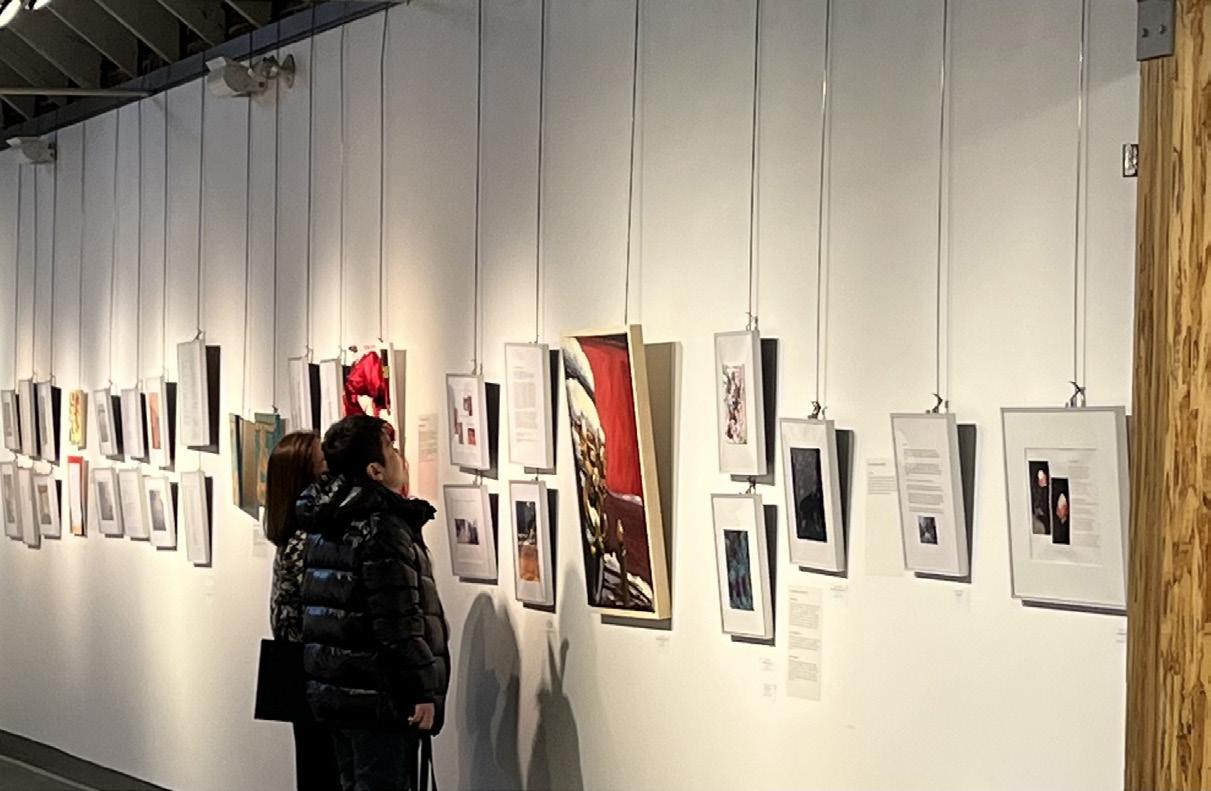
The project was created by CultureLink, a community organization that focuses on connecting cultures to build stronger communities. Their services and programs are catered towards refugees, youth and seniors.
The organization’s Anti-Racism Action program held a storytelling workshop in which 75 per cent of its participants were women.
Through conversation and collaboration among the women came the inspiration to create the organization’s first-ever Women of Courage art exhibition with plans to tour gallery spaces across Toronto this spring.
The exhibition started its tour at Todmorden Mills Heritage Site in Toronto on Feb. 15 and will be making stops at the Scarborough Museum and Gibson House Museum before ending at Montgomery’s Inn on June 4.
Christina Chu, the manager of special programs for CultureLink, said they were impressed with the
stories the women were creating, and thought the exhibition would be a great way to inspire women.
Chu said a great deal of outreach work was done in order to connect with the women who wished to share their stories.
“We had gone to arts community centres, unions, non-profit organizations, and immigrant-serving organizations, that’s how we brought all these folks together,” she said.
The exhibition is composed of four installations that showcase various aspects of the artist’s experiences.
One of the installations was the Women of Courage Mosaic Film.
The film features interviews of the artists discussing their experiences with migration, the struggles they’ve had to overcome, as well as their victories throughout their lives.
The film was produced and edited by Henry Mak. He was assisted by Alana Beyonce, Massuco Ricalde, Zohra Safari, Fabiola Escalante and Esther Mbabane, all of which are youth artists.
Various sound installations are also on display to provide viewers a peek into the women’s sonic memories.
Artist Carmen Gao’s sound installation tells a three-generation family story of the past and present.
Gao’s sound piece starts with the
voice of her father giving a speech at her wedding in 1994. It then transitions into the sound of a sewing machine where her fashion-designer daughter, Benita, is sewing her newly-designed pair of pants. The story then moves along to the voices of Gao and her son practicing the lines for his next audition.
Gao’s story, along with the other sound installations can be found on CultureLink’s website and on the SoundCloud page.
Another artwork display was the Land Acknowledgement installation, which was created to reflect the women’s understanding of settlement on Indigenous land.
The last installation is the Wall of Grievances, a wall filled with written stories, paintings, photographs and other forms of artwork that voice the oppression, racism, loss, homesickness, and victories that the artists have experienced.
One of the stories on the wall was written by Rabia Qoraishi. It details the tale of a pregnant woman’s experience taking the TTC to go to her English class in the evenings.
Beside the story stands a photograph of a TTC bus stopped at a street intersection on a winter night in the city.
The stark image beside the story brought to life the dangerous real-
ities that pregnant, immigrant women face while trying to navigate new settings at vulnerable moments in their life.
Chu said the exhibition is not only a way for the women to voice their experiences, but for deeper, intergenerational work to be done.
“The creation of this opportunity is important for intergenerational work to allow understanding to happen between generations and remove regrets,” she said.
Chu said the project gave the women the opportunity to find themselves again and move forward.
“Some women who have been writing put their pens down for many years to deal with life, now
they are able to pick the pen up again,” she said.
Chief Executive Officer of CultureLink’s Settlement and Community Services, Jemima Sabapathy, said in a statement the exhibition allows racialized immigrant women to come together in a safe space to understand each other’s experiences in Canada.
Sabapathy wishes the exhibit will create discussion surrounding racism and discrimination.
“We hope that their personal stories will spark self-reflection and dialogue around racism, discrimination and inclusion, issues that touch all persons in Canada,” she said.
The Humber women’s basketball team cruised to victory on Wednesday, beating the Augustana Vikings 84 to 63 during the Canadian Collegiate Athletic Association’s quarter final game in Hamilton on March 15.

The Hawks went into this tournament as the reigning Ontario College Athletics Association champions. The University of Alberta - Augustana team, from Camrose, Alta., are that province’s second place finishers.
The Hawks were led by their head coach Ajay Sharma, who was part of the winning CCAA team in 2018, the last time the tournament was held in Ontario.
Despite being slightly shorthanded due to a number of injuries, the team caught fire during the second quarter and led by nine points at halftime.
This was in great part due to some impressive shooting, spearheaded by starting guard Brittney English.
English scored 18 points before the end of the first half, shooting three for four from beyond the arch. The fifth year guard finished
with 23, and was named player of the game for the Hawks.
In her post-game interview, English said despite having just won the provincials, she was aware that competing in nationals was a whole new beast.
“Honestly, we just came to compete, compared to our provincials, nationals are a much grittier game,” she said.
English also spoke with confidence about her team and their performance in the game.
“We came into this game with our mindsets to just compete and play what we know how to play,” she said.
The Hawks managed to win every conference game this season, except for their match against Lambton College which Sharma called a bump in the road.
Lauren Cardinal nabbed the title of player of the game for the Vikings.
She maintained energy and a fast pace throughout the game, especially in the second half where she grabbed every rebound that came her way. She finished the game with 11 rebounds and five steals.
Ultimately, the Hawks were able to break through the Vikings defence as they struggled to guard
the interior throughout the game. All-Canadian guard Kia Watt added 22 points of her own, shooting an impressive 52 per cent from the field.
After their victory at Mohawk College, English stressed the
importance of continuing to play aggressively going forward in this competition.
She also credited her teammates for supporting her on the court which allowed her to play with more confidence and score those
23 points.
With this win in Hamilton, the Humber Hawks are on their way to a Thursday semi-finals against Geants de Saint-Jean, who beat Atlantic provinces champ Mount Saint Vincent University Mystics 84-71.
the 23 players who will have the opportunity to wear the Maple Leaf on home ice and compete for a gold medal in front of friends, family, and Canadian hockey fans,” Kingsbury said.
“It is special to host women’s worlds in Canada and welcome the nine other competing federations while showcasing the talent and class of competition in our game,” she said.
“We know the atmosphere in Brampton will be electric and we are excited for the chance to go for gold next month,” Kingsbury said.
Hockey Canada has released its 23-player roster that will represent the country on home ice at the 2023 International Ice Hockey Federation (IIHF) Women’s World Championship in Brampton next month.

The team will look to capture its third straight gold with some
familiar faces.
Eighteen players selected to the roster were part of Canada’s championship team last year in Denmark, and all players except forward Danielle Serdachny have previously appeared in a world championship.
Head coach Troy Ryan was part of the coaching staff that won back-toback gold medals at the 2021 IIHF
Women’s World Championship in Calgary and the 2022 Olympic Winter Games in Beijing, China.
He said in a statement that picking out the roster was not an easy decision.
“Our staff had some very difficult decisions selecting this roster and that speaks to the depth that we have within our program,” he said. “We are confident that we have assem-
bled a talented roster with a great deal of character and leadership.
All games will be played in Brampton at the CAA Centre, bringing the international competition to the GTA for the first time in more than 20 years.
Gina Kingsbury, director of hockey operations, said playing on home ice will be special.
“We are extremely excited for
The 10-team tournament features Canada in Group A with Czechia, Japan, Switzerland, and the United States, while Group B includes Finland, France, Germany, Hungary, and Sweden.
Canada will kick off the 2023 IIHF Women’s World Championship against Switzerland on April 5, and followed with Czechia on April 7 and Japan on April 8.
It will close out the preliminary round against its rivals, the United States, on April 10, with all Team Canada preliminary-round games starting at 7 p.m. EST, 4 p.m. PST.
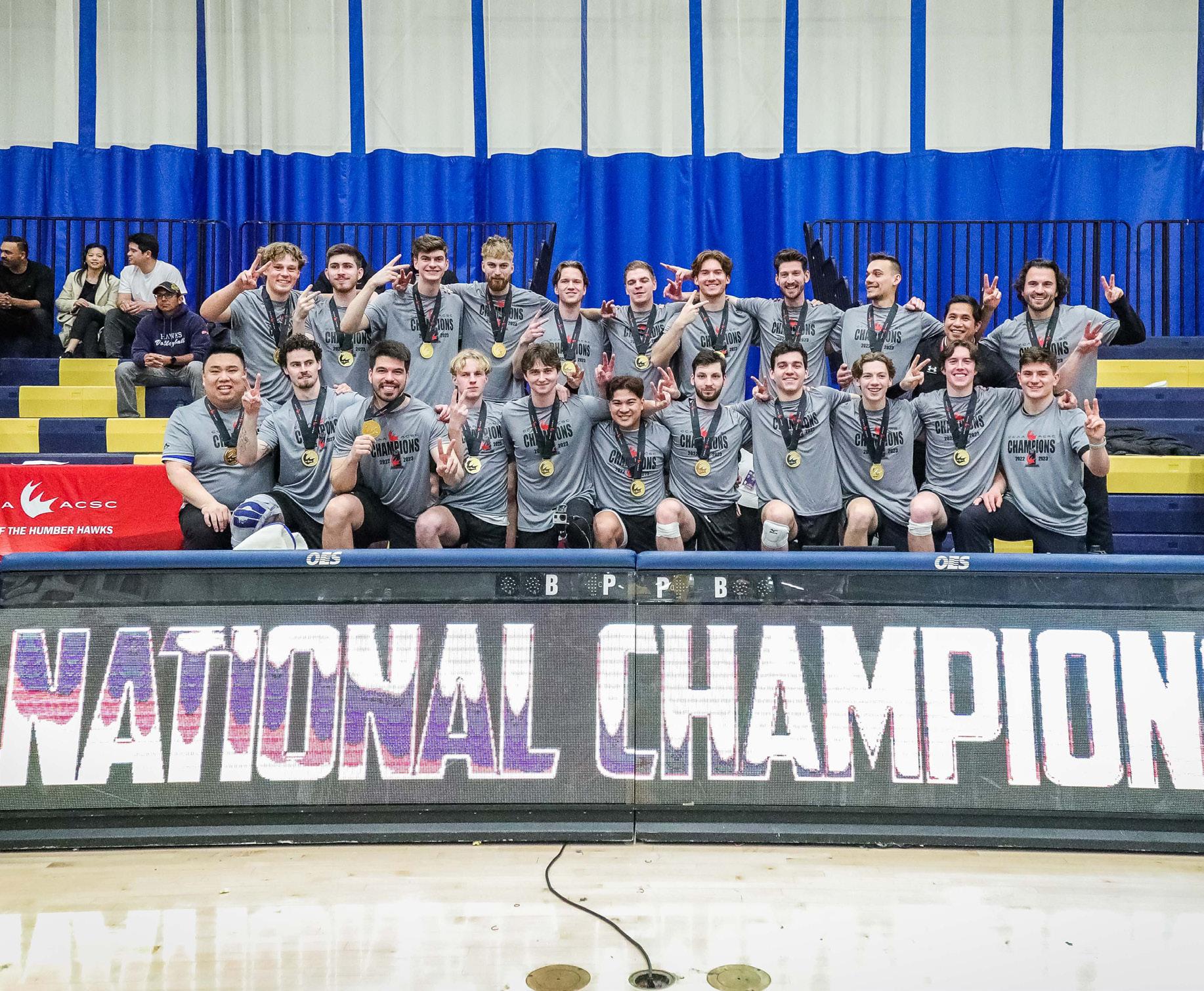
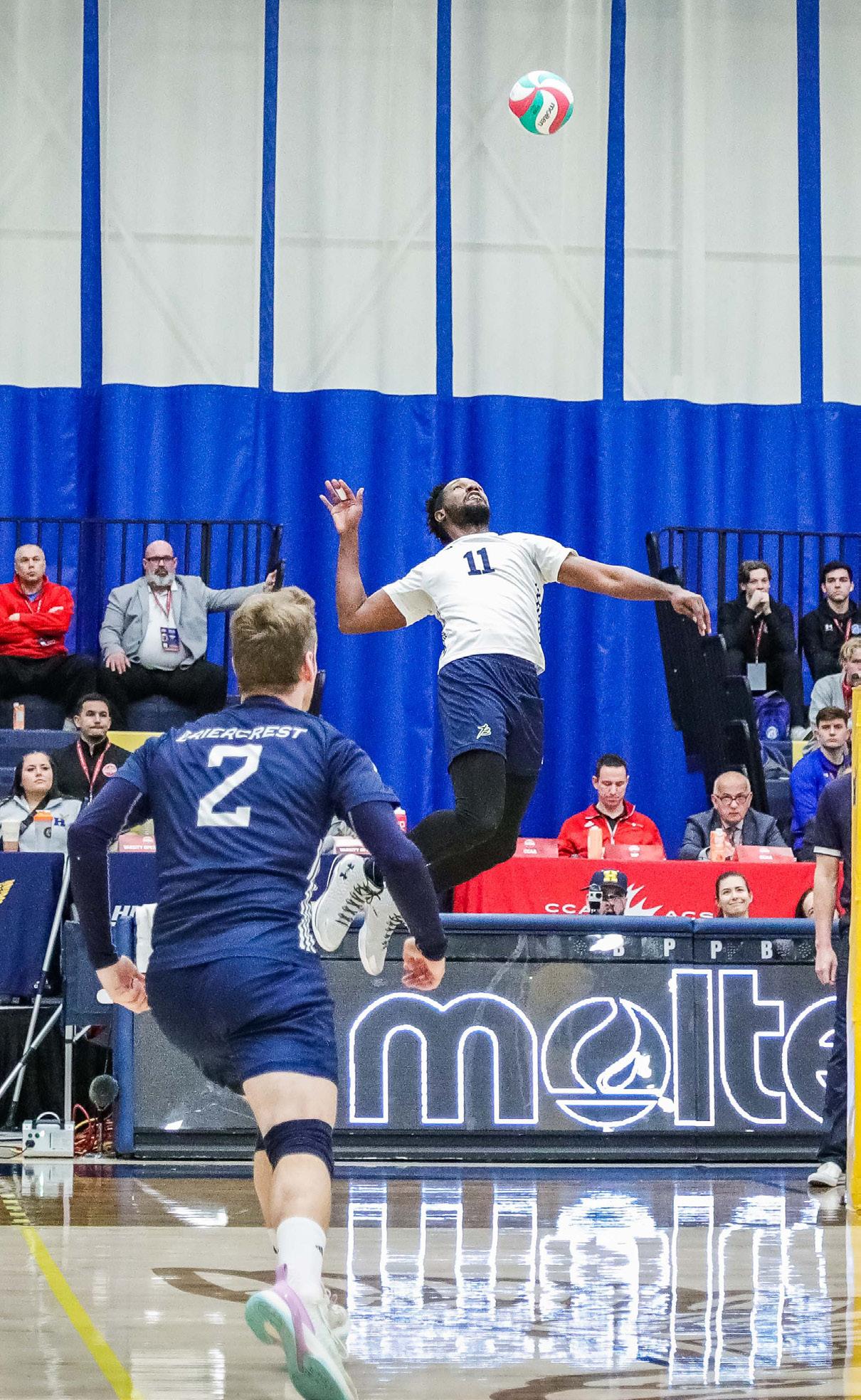 Samuel Belton Sports Reporter
Samuel Belton Sports Reporter
The Camosun Chargers have won back-to-back CCAA gold medals, defeating the Hawks on their home turf.
It was not a happy night for the Humber men’s volleyball team.
The Humber Hawks, who had won the 2022 OCAA provincial championship, suffered a clean sweep 3-0 loss to the Camosun Chargers yesterday night.
The Chargers from the Victoria, B.C., college won the CCAA gold medal for the second year in a row. They came into nationals with a Pacific Western Athletic Association (PACWEST) provincial record of 19-1. This dominated over Humber’s 13-5 Ontario Colleges Athletic Association (OCAA) provincial record of 13-5.
Both teams won their respective provincial championships.
The game was not one-sided and very competitive, but the Chargers always seemed one step ahead of the Hawks. The set scores were, respectively, 19-25, 22-25, and 20-25.
Humber assistant coach Mack Robertson said it was not the performance they hoped for and they didn’t quite rise to the occasion.
“We did so well. From second semester on, we went 12 and one, and we did so many good things, and got better and better every game, [and] every match,” Robertson said.
“The guys worked so hard,” he said.
Robertson said he is very proud of the Hawks team for how hard they worked, and said it was awesome to be in this game. He also said the coaches’ job with college students is to build them up, help them learn, and prepare them to move on with their lives.
“You learn a lot by winning and you learn more by losing and we’re gonna do what we can and be ready for the next one,” he said.
Robertson praised his team for performing well under pressure but said Camosun was just a little better at that.
“We just could not break through. We couldn’t get them back on their heels and they kept pressing us,” he said.
Humber middle blocker Jaskarn Kalsi, who was crowned the Player of the Match, felt defeated by the loss.
“It’s tough to hold my head high. But I’ll do it for myself and I’ll do it for the guys, the guys coming back next year,” Kalsi said.
Kalsi said it was nice to be the player of the game but the reality is people do not remember individual players winning awards as much as the team that won the championship.
“It’s not the one [award] I wanted,” he said.
“We had an okay level of play, both personally and as a team but collectively we just weren’t able to go on runs and stop runs as much as we should have,” Kalsi said. “That’s what ultimately cost us [the win]. But it is what it is, you live and you learn.”
To improve for next season, Kalsi said the team should work on continuing to perfect blocking and defense.
“We gotta work on a whole lot before we win a gold medal,’ he said.
Kalsi was also given the 2023 OCAA First-Team All-Star award.
The Camosun Chargers did not lose a single game in the CCAA championship held at Humber’s North campus.
Chargers head coach Kelvin Ma, who in his first season at the helm, said Saturday’s match was their best of the year.
“We had two days to prepare, [and] the warmups, and practices were very good,” Ma said.
Ma said his team has played good teams all season, and have done thorough preparation for the championship.
“I don’t think this weekend was particularly better than the others. But I think our championship performance was really good,” he said.
Ma said right up until Christmas break, they were trying to figure out their identity, and from January on, they were comfortable. By the playoff season, they felt like a team. They are losing key players, and learning lessons from that, but they are confident for next year and excited to host.
“I think the people we have on the bench are capable of taking over,” he said.
Camosun setter Lucas Maffia, who was awarded the Player of the Match for his team, scored 21 assists, eight digs, and four kills.
He said his skills improved significantly throughout the season.
“We had an assistant coach spe-
cifically for setting and he helped me a lot with little things all season long,” Maffia said.
He said he is headed to a different school next season.
“It’s kind of bittersweet, this win, but I’ll continue to develop and maybe get a medal over there as well,” Maffia said.
Chargers right side Jordan Fulljames, a rookie, called tonight’s game ecstatic.
“Going into it, we were all prepared for a win. That was our mentality,” Fulljames said.
He said his team would not have allowed anything else, and the hard work throughout the season paid off.
“In practice, it was always intense, and when it wasn’t, all the guys were honest to make sure we were prepared for this moment exactly,” Fulljames said.
He is proud to be part of this team. He wants to stick with the Chargers, considering how high up they are in British Columbia, and in Canada.
The 2023 CCAA gold medal Camosun follows the gold in 2022 and 2015, as well as taking home a bronze in 2009.
Camosun Chargers won the gold, Humber Hawks took silver and Briercrest Clippers claimed bronze
The Briercrest Clippers took the bronze medal after defeating the VIU Mariners in straight sets at the men’s volleyball national championship tournament.
The Briercrest Clippers took the bronze medal home to Saskatchewan after defeating the VIU Mariners in straight sets at the Canadian Collegiate Athletic Association (CCAA) men’s volleyball national championship tournament.
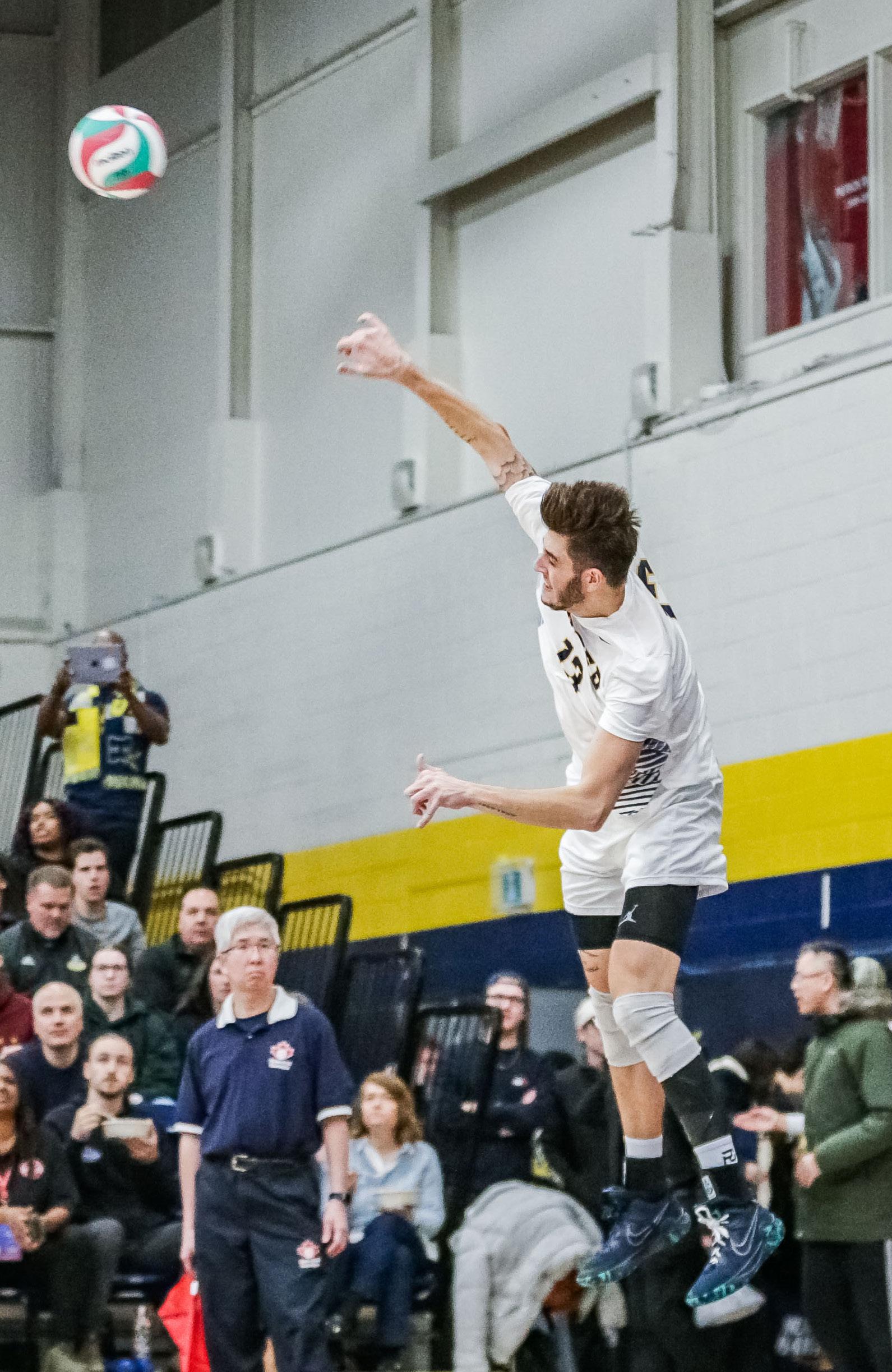
The Clippers came into nationals as the Alberta College Athletics Conference (ACA) champions which posed a challenge for the Mariners, who came in as one of two wildcard spots after winning the silver medal in the Pacific Western Athletic Association (PACWEST) championship.
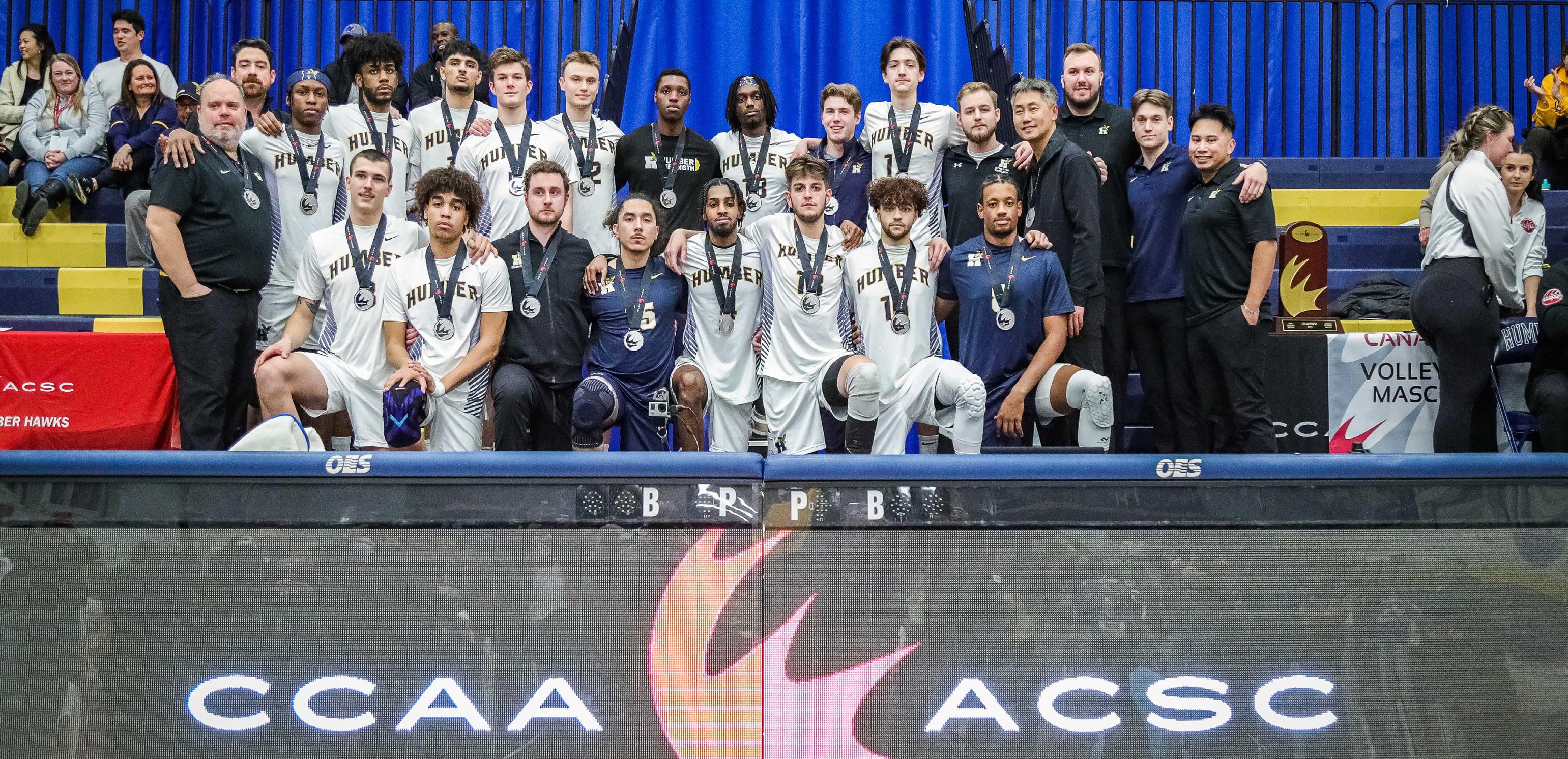
The match was a battle in every
set with the Clippers coming out on top, 25-22, 27-25, and 25-19.
Briercrest’s right-side hitter and a CCAA All-Canadian, Karym Coleman was proud of the way the team performed.
“We had a couple of lapses, but we never let the game get away from us,” he said. “I liked the way that the team held it together and came together as brothers on the court and just fought for the victory.”
The quest didn’t start the way they wanted, losing the first game against the Fanshawe Falcons. But
two games, losing only one set in that span, to earn their spot in the bronze medal final.
Their mettle was tested again when it was announced 20 minutes before the game that one of their starters had to be sidelined because of concussion protocol.
Mullan was once again pleased with their perseverance.
“To see their ability to dig deep and have lots of character to show up and to embrace the adversity, I’m really proud of them,” he said.
It has been a long time since the Clippers were on the national stage.
Clippers head coach Nigel Mullan knew they would need to rely on the lessons of adversity from the regular season to do well in the rest of the tournament.
“This is a group that has shown resolve throughout the season, and when we face adversity we’ve done a pretty good job of responding, and so I would expect no difference in the group here,” he said.
They went on to win the next
This tournament is the first time they’ve been back since winning the silver medal in 2014, so walking out with a piece of hardware was a goal.
Coleman said even though it’s a bronze medal, it’s still a win not only for the team but for the school.
We haven’t been to nationals in about nine years so this is big for our program, and this is big for the group,” he said. “Coming from such a small school of about 580 students, we’ll take it.”
“THIS IS A GROUP THAT HAS SHOWN RESOLVE THROUGHOUT THE SEASON, AND WHEN WE FACE ADVERSITY WE’VE DONE A PRETTY GOOD JOB OF RESPONDING,”
Nigel Mullan Clippers Head CoachThe Humber Hawks men’s volleyball team wins the 2023 CCAA silver medal after playing against the Camosun Chargers on March 11, 2023. Briercrest Clippers finished with bronze.
